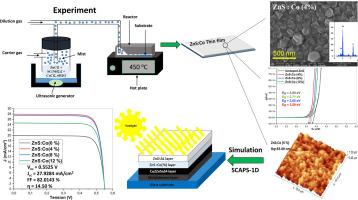Experimental and numerical insights into Co-doped ZnS buffer layers for high-efficiency solar cells
IF 4.3
Q2 CHEMISTRY, PHYSICAL
引用次数: 0
Abstract
This study explores the influence of cobalt (Co) doping concentration on the structural, morphological, optical, and electrical properties of zinc sulfide (ZnS) thin films. Both undoped and Co-doped ZnS thin films were successfully deposited on glass substrates using an economical and scalable ultrasonic-assisted chemical vapor deposition (Mist CVD) technique at a substrate temperature of 450 °C. A comprehensive characterization was performed using X-ray diffraction, Raman spectroscopy, scanning electron microscopy, atomic force microscopy, UV–Vis spectrophotometry, and Hall effect measurements. To assess their device relevance, SCAPS-1D simulations were performed by incorporating ZnS:Co as buffer layers in thin-film solar cells. The results show that 4 % Co doping enhances the optoelectronic properties and achieves the highest simulated efficiency of 14.50 %. These findings demonstrate that controlled Co incorporation is a promising route for tailoring ZnS thin films toward efficient buffer layers in photovoltaic devices.

高效太阳能电池共掺杂ZnS缓冲层的实验与数值研究
本研究探讨了钴(Co)掺杂浓度对硫化锌(ZnS)薄膜结构、形态、光学和电学性能的影响。采用经济、可扩展的超声辅助化学气相沉积(Mist CVD)技术,在450°C的衬底温度下成功地在玻璃衬底上沉积了未掺杂和共掺杂的ZnS薄膜。利用x射线衍射、拉曼光谱、扫描电子显微镜、原子力显微镜、紫外可见分光光度法和霍尔效应测量进行了全面的表征。为了评估其器件相关性,将ZnS:Co作为薄膜太阳能电池的缓冲层进行了SCAPS-1D模拟。结果表明,4%的Co掺杂提高了光电性能,达到了14.50%的最高模拟效率。这些发现表明,可控Co掺入是一种很有前途的途径,可以将ZnS薄膜定制为光伏器件中的高效缓冲层。
本文章由计算机程序翻译,如有差异,请以英文原文为准。
求助全文
约1分钟内获得全文
求助全文
来源期刊

Chemical Physics Impact
Materials Science-Materials Science (miscellaneous)
CiteScore
2.60
自引率
0.00%
发文量
65
审稿时长
46 days
 求助内容:
求助内容: 应助结果提醒方式:
应助结果提醒方式:


